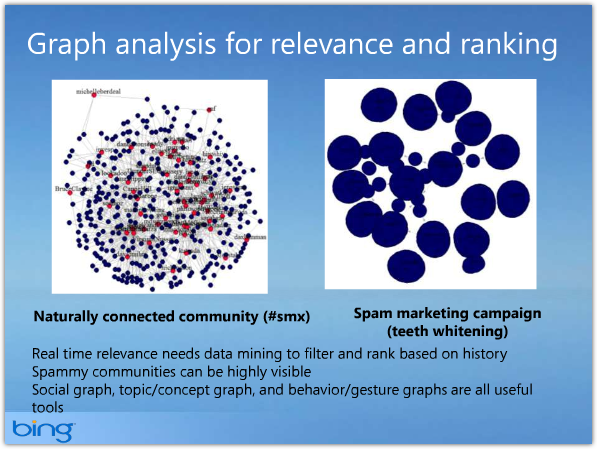What would Google look like if it relied exclusively on the nofollow link graph? It would be a sort of Bizzaro Google. We’ll call it Elgoog.

In this search engine Matt Cutts would help ensure every SERP contained at least one result for Viagra.
Sounds like the stuff of comic books. Yet, I think the nofollow link graph could actually be useful in improving search quality.
Types of NoFollow Links
First, lets think a bit about the nofollow link graph. It isn’t homogeneous. There are different types of nofollow links and they should carry different weights within the Elgoog algorithm. I see six general classes of nofollow links: Administrative, Sculpting, Advertising, Editorial, Social and Comment.
Administrative nofollow links are internal links used for areas such as log-in, privacy, ratings or feedback. They’re generally benign.
Sculpting nofollow links are internal links used to ‘hoard page rank’ or to ensure anchor text focus. The latter is something I don’t see discussed much when abandoning the idea of page sculpting. If Google isn’t passing anchor text through nofollow links, you might find it useful to put a nofollow on obtuse and extraneous links such as ‘read more’. Whatever your position on page sculpting, it’s a type of manipulation.
Advertising nofollow links are external links used to identify paid links.
Editorial nofollow links are external links used when one site is explicitly not endorsing another site. If Aaron Wall ever linked to Mahalo you better believe he’d use a nofollow. These links are incredibly rare and, as such, quite valuable.
Social nofollow links are external links used by social platforms such as Twitter and Facebook. They could conceivably be deemed sculpting or editorial nofollow links but I’ll split them out here since they’re probably a big piece of the nofollow link graph.
Comment nofollow links are external links used in blog comments and forums. In the last two years it seems clear that Google can determine the location of a link – that the link comes from text, the footer, navigation or comments. The comment nofollow graph is where you’ll find an enormous amount of spam.
NoFollow Link Graph
The nofollow link graph would power the Elgoog algorithm. Sites with a high sculpting to total link ratio would rank well. Similarly, a high advertising to total link ratio may boost your Elgoog rank. Editorial nofollow links would provide a lift to the linked site. And of course, sites that receive a large amount of comment nofollow links would shoot to the top of Elgoog results.
In looking at just the comment nofollow link graph it seems like it should be pretty easy to identify spam. Elgoog loves spam! Remember my comment spam examples? Those comments all have links that would help that site rank well in Elgoog. As such, they should rank nowhere near the top in Google.
See how that works. If it ranks high in Elgoog, it ranks low in Google. Your Elgoog score is a signal. Sounds crazy, but on some level I feel like it might work.
Measure Unnatural Link Behavior
If people no longer naturally link, why not measure the inverse? Measure the unnatural link behavior.
At SMX West 2010 Bing made a presentation on Social Search that included an interesting slide that showed the difference between a natural community and a spam community.

The difference is rather stark. Spam was highly visible.
Elgoog would reward sites with obvious link exchange schemes. It would seek out uniform anchor text. And those that received links from sites completely off topic would also benefit. In fact, Elgoog might require topic diffusion in your link graph. (Sites about lawn mowers better have links from wedding dress and online chess sites.) Of course, large amounts of links should be built in a short time frame. Slow and steady link profiles would be frowned upon.
Elgoog and the nofollow link graph could help measure manipulated trust and authority or, at a minimum, trust and authority disinformation. As the link graph degrades, wouldn’t that be a valuable signal?
Maybe Google does this already. Or they’ve poked at it and found it flawed. (I can already poke holes in it myself.) Yet, I feel like there’s a thread of potential here. Rooting out manipulated trust and authority seems a far better initiative than judging content farm quality.
What do you think?
The Next Post: Valentine’s Day Thank You
The Previous Post: How To Quickly Identify Comment Spam

3 trackbacks/pingbacks
Comments About Google Should Follow NoFollow Links
// 2 comments so far.
Jon Henshaw // February 13th 2011
Nofollow is a joke, and I seriously doubt that Google uses it in the way they want us to think they use it (assuming they still use it all). With that being said, and knowing how much people use it, the vaporware Elgoog sounds intriguing 🙂
aj // February 16th 2011
Jon,
Thanks for the comment. I too would like to know how Google really uses nofollow, if at all. They’ve become more vocal about the fact that nofollow links aren’t a part of Page Rank and that anchor text from nofollow links is not a factor either.
Of course, we’ve all learned to parse statements (particularly from Matt) with a fine tooth comb. With that in mind, I don’t think Google has confirmed that nofollow links aren’t some sort of algorithmic signal. Conversely, one would think that if they were (or were an important one), certain comment spam link abusers would have been blacklisted long ago.
In all, this is just another sad diary entry in the decline of the link graph.
Sorry, comments for this entry are closed at this time.
You can follow any responses to this entry via its RSS comments feed.